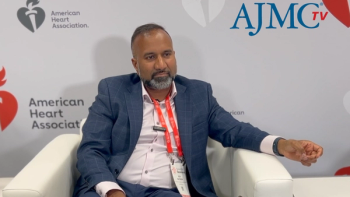
Challenges in Getting Access to an Initial Pediatric Dermatology Appointment: Elizabeth Garcia Creighton
Accessing pediatric dermatology care is challenging due to a shortage of specialists and general dermatologists' reluctance to treat children, but increasing their comfort level with seeing children could help bridge the gap, explained Elizabeth Garcia Creighton, of University of Colorado School of Medicine.
With a shortage of pediatric dermatologists, getting access for a first appointment can take a long time, and many general dermatologists are not accepting pediatric patients, although the reasoning is not always clear why, explained Elizabeth Garcia Creighton, BA, a medical student at the University of Colorado School of Medicine. In some cases, education among general dermatologists and an increased comfort level with seeing children may help.
Creighton presented her findings at the
These answers have been edited for style and clarity.
The American Journal of Managed Care® (AJMC®): What are some ways to help general dermatologists get more comfortable accepting pediatric patients, especially considering there are so few pediatric dermatologists that are really available?
I think that's a really important point, and something that I really want to focus the future research on is education. For general dermatology residency, you do an intern year, which is general medicine typically, and then you do 3 years of dermatology residency. One thing I wanted to see is if there were differences between people who were at a residency that had an affiliated pediatric hospital, for example, a children's hospital, and people who went to a residency that did not have a children's hospital, so they did not get much exposure to [pediatrics]. That could be a difference, or even if the residency itself has any pediatric dermatologists, whether they actually have faculty on the residency that are pediatric dermatologists that are teaching the residents how to treat children.
Those are a couple of things that maybe might lead to, if we improve the rates of residencies with children's hospitals, or that would be pretty hard, but if we improve the exposure for residents to see children, then maybe more general dermatologists in the future would feel more comfortable seeing children. That's one thing [to examine] is the education itself, and that could help us. That might be an assumption that we don't really know why they're not seeing children.
It could also be preferences. Maybe people go out into the field, and they're think, “Well, I would rather see adults, because I'm really comfortable doing biopsies and stuff,” and usually with children, we try not to do biopsies firsthand, especially with a baby. That could be a difference too. It's a little bit of an assumption to say, “Oh, maybe it's education based.” Definitely, more research needs to go into the why part—why are there these differences? Why are many general dermatologists choosing not to see children?
The nice part is, if it's education, we can target it somehow. We hope it's that versus just like a preference.
AJMC: Your research looked specifically at new patient appointments. Do we know anything about follow-ups? Are there access issues with getting a follow-up appointment?
Our research didn't look into follow ups at all. It was a little bit hard with a mystery caller, because the way we did it was people would call clinics and try to schedule an appointment, and so if you had a follow up, I'm sure you would probably have a patient portal, and maybe they could link it so it would probably be easier. I'm assuming it would likely be easier to get a follow-up appointment.
What we did find is that a lot of clinics in general were not taking new patients. That was one of our exclusion criteria. There were actually many, many clinics that said “So-and-so is not taking new patients right now because their practice is full both for adults and for children.” In general, the research has shown that it's harder to get new patient appointments than it is to get follow ups once you're in the system. I think it's easier to have like follow-up care and access.
Something that's interesting is the initial point of contact is really hard to make. It's really hard to get access that first time. Even when we talk about how all pediatric dermatologists would take children, that's great, but there aren't very many pediatric dermatologists, and there are not very many pediatric hospitals. For example, in Colorado, we have 1 [pediatric hospital], and we have people drive like, 5 hours and 6 hours from all over to try to get to this hospital. Even when you think about it, for a new patient appointment, to try to wait for months to get into the pediatric clinic, and then finally, when they get in to have a 5-hour drive, most people have to stay in Denver [and] get a hotel in Denver for the night or something. It's just hard. The initial point of contact is hard.
Afterward follow up [appointments]…sometimes Zoom helps. Sometimes you can do telehealth. Not always, though, but in general. I would say other research has shown that it's harder to get the initial point of contact, the new patient appointments, than it is to get follow-up care usually.
Newsletter
Stay ahead of policy, cost, and value—subscribe to AJMC for expert insights at the intersection of clinical care and health economics.






























































